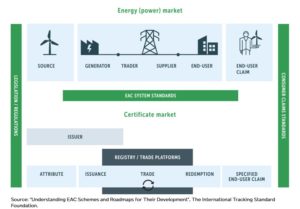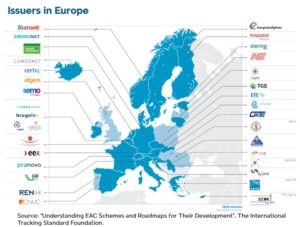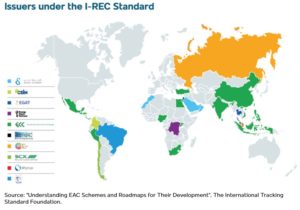EAC:
If you hear about EAC for the first time and google it, you’ll be confused for a brief moment. The acronym is widely used by various groups for different concepts. I am talking about the EACs in the sustainability context, as in EnergyAttributeCertificates .
EAC is a generic term that represents similar content but is named differently across regions. Below are some of the names used around the world, and there are many more specific acronyms on national level.
National, regional and international schemes
- Europe: GoO
- UK: REGO
- USA & Canada: REC
- Japan: J-credits, GECs, NFCs, I-RECs
- China: GECs, I-RECs, TIGRs
- India: I-RECs, TIGRs
- Australia: LGCs
- New Zealand: N-ZECs
- Rest of the world: I-RECs, TIGRs
EAC-related Accronyms
o GoO: Guarantees of Origin
o REGOs: Renewable Energy Guarantees of Origin
o RECs: Renewable Energy Certificates
o J-credits: Japan’s certification scheme
o GECs: Green Energy Certificates
o NFCs: Non-Fossil Certificates
o TIGRs: Tradable Instruments for Global Renewables
o LGCs: Large-scale Generation Certificates
o N-ZECs: New Zealand Energy Certificate System
o I-RECs: International Renewable Energy Certificates
So, what is it about?
An EAC is a sort of contract that indicates the attributes of a unit of energy (typically 1 MWh of electricity ). The certificate includes information on
- the technology used to generate the energy (e.g. solar PV, wind turbines)
- the underlying energy source, if any (e.g. gas, coal)
- the start and end dates of production
- the identity and location (e.g. a unique identifying number)
- the capacity of the generating installation (in megawatts or gigawatts)
- the year the generating installation was built
- the date on which the generating installation became operational
- if the installation received public support (e.g. feed-in-tariff, investment support)
Interesting part is that EACs, like many other assets, can be held, traded and retired (cancelled) in specific tracking systems.
Why would a company need an EAC?
Let’s go back a bit. Energy can be generated from
- nonrenewable, high-emission sources (e.g. fossilfuel),
- renewable , low-emission sources (e.g. solar, wind, hydro, geothermal) and
- non-renewable, low emission sources (e.g. nuclear).
Utility companies might collect and mix different types of energy and distribute it via regional grid to end users (organizations and households). Without documentation and verification, it is impossible for the buyer (e.g. company) or the seller (e.g. energysupplier) to quantify the green energy portion within the total traded energy and claim a reduction in emissions.
EACs are tracked with EAC systems to quantify the environmental benefits, associate the benefits with the correct parties and avoid double counting the emission reduction.

Source: “Understanding EAC Schemes and Roadmaps for Their Development”, The International Tracking Standard Foundation
What are the benefits of EACs?
EACs contribute to clean energy targets of the energy suppliers and the end users. On the largest scale, it benefits the Environment, and all the internal & external stakeholders of companies. More specifically, it helps with
- validating energy suppliers’ claims about low emission energy generation
- validating companies’ claims about renewable energy use and environmental responsibility
- leaner greenhouse gas accounting and significant reduction in Scope 2 emissions
- adhering to power source and emissions disclosure policies.
- adhering to the standards of CDP, RE100, SBTi, etc.
- affordable and easy reduction of emissions in counties where PPA or company-owned on-site generation is too costly or complicated
- higher control over the cost and time spent to reach renewable energy targets
- higher control on the choice of renewable energy source
- ability to trade EACs like other assets
- substantiated support for the renewable energy initiatives of power generators.
How does an EAC work?
The process for companies is straightforward. They buy an EAC, retire it and claim the benefits listed on the certificate.
- A unit of energy (typically 1 MWh) is generated by a producer.
- For each eligible MWh of energy, the relevant issuing body issues an EAC.
- EAC market participants trade these certificates and finally sell them to end-users. End user can also buy it directly from the generator.
- Once bought, an EAC is cancelled (retired) by the end-user and removed from the energy accounting pool.
- The end-user registers the consumption of that low emission MWh and claims the attributes listed in the EAC.
Issuers in Europe and around the world

The diagram above shows the EAC issuing bodies in Europe and the one below shows the issuers under the I-REC Standard. The 2020 publication “Understanding EAC Schemes and Roadmaps for Their Development” by the International Tracking Standard Foundation is available online and it provides more information on the topic.

How different is it from carbon credits?
An EAC that is held and used (retired / cancelled) by a company proves that the indicated amount of energy was generated from the renewable, low-emission sources. In other words, the company does not cause high emissions in the first place. EACs are issued and claimed in the same region as the company facility that consumes the energy.
A carbon credit represents the company’s financial support for the projects that capture, remove or avoid GHG emissions. This engagement focuses on compensating for the negative impact of the emissions that are already caused by the company. Carbon credit projects do not have to be located in the same region as the buying company.
Another way to look at the differences is provided by the US Environmental Protection Agency. As the scheme is called Renewable Energy Certificate (REC) in USA, we will share their nomenclature.
| Basic Differences | Offsets | RECs |
| Unit of Measure | Metric tons of CO2 or CO2 Equivalent | Megawatt hours (MWh) |
| Source | Projects that avoid or reduce greenhouse gas (GHG emissions to the atmosphere) | Renewable electricity generators |
| Purpose | Represent GHG emissions reductions; provide support for emissions reduction activities; and lower costs of GHG emissions mitigation | Convey use of renewable electricity generation; underlie renewable electricity use claims; expand consumers’ electricity service choices; and support renewable electricity development |
| Corporate GHG Inventories and Reporting | Reduce or “offset” an organization’s scope 1, 2 or 3 emissions, as a net adjustment | Can lower an organization’s gross market-based scope 2 emissions from purchased electricity |
| Consumer Environmental Claims | Can claim to have reduced or avoided GHG emissions outside their organization’s operations | Can claim to use renewable electricity from a low or zero emissions source |
| Additionality Test Requirements | Required. Each project is tested for additionality to ensure that it is beyond business as usual. Tests include legal/regulatory, financial, barriers, common practice and performance tests. The combination of tests that is best suited to demonstrate additionality depends on the type of project. | Not required. Project additionality is not required for a renewable energy usage claim or to report use of zero-emissions power. |
Source: “Offsets and RECs: What’s the Difference? ”, USA Environmental Protection Agency & Green Power Partnership
As they are different but complimentary tools, a company can use both EACs and carbon credits for the same reporting year. Firstly, EACs help reduce the indirect emissions, and carbon credits help offset the remaining emissions.
Feel free to reach me at ozge.ozdemir@ascentys-esg.com if you have any questions or remarks.
Disclaimer: This post is organically created (without AI) 😊 as a practical management summary. There are various sources of information on the web, but I particularly thank the authors of the 3 sources I quoted here. If you are interested in learning more about EACs, I encourage you to read the source documents, all of which are publicly available online.
References
- USA Environmental Protection Agency https://www.epa.gov/green-power-markets/energy-attribute-certificates-eacs
- USA Environmental Protection Agency & Green Power Partnership, “Offsets and RECs: What’s the Difference?”
- The International Tracking Standard Foundation, “Understanding EAC Schemes and Roadmaps for Their Development”
- Picture: storyset on Freepik

